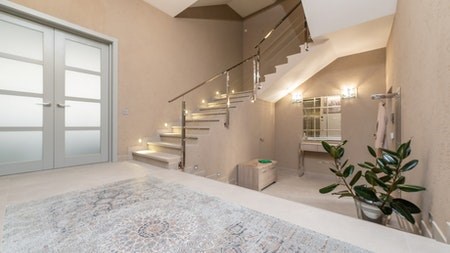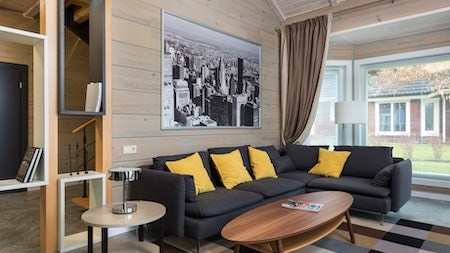The ‘wellness home’ appears to be a rapidly-emerging trend globally. In fact, it is not so much a trend given that associated measures have been implemented over decades, but we now have a word for it, and one that aligns neatly with the environmentally-conscious movement.
Not to be confused with an environmentally-friendly home, although there are some cross-overs, the wellness home is more concerned with a residential space that provides for healthier living and improved human health. Over the past 100-odd years, our homes have become more sophisticated in terms of engineering, sanitation, building standards, and technology, to mention a few. Whilst such developments are important, they have brought about new health risks and a move away from a more nature-connected environment. With a global consciousness to ‘return to wellness', there is an emerging attitude change about how human beings live and interact in our homes. The Covid-19 pandemic certainly highlighted the need for this.
Being purpose-minded about how residents interact in the wellness home does not have to be expensive. In fact, there are innumerable ways that things can change with little to no cost.
There are a number of basic concepts that help create what may be considered a wellness home, such as:
Clean and dry homes:
A dirty home is one of the biggest contributors to a multitude of health problems. For one, dust mites increase, which can escalate into a huge irritant for those with allergies or asthma. Mould, if left unattended - in the shower, for example - can inflame airways. The worst case scenario may mean reduced lung capacity and even cause asthma to manifest. Typical bathroom bacteria is E-Coli and staphylococcus, which can bring about stomach upsets and sickness. Dirty bedsheets can introduce bacteria that may cause the contracting of rhinitis. And, if care is not taken in the kitchen when prepping meals, there is a chance of cross-contamination between raw meats that can cause salmonella and other food poisoning illnesses.
A clean home goes hand-in-hand with a dry home. Wet and humid environments are a prolific breeding ground for the growth of mould spores. Consider that research has proven that infants exposed to mould in their living environments are up to three times greater risk of becoming asthmatic in their first year of life. There is also the obvious danger that wet environments impact significantly on wood features in a home, which not only deteriorate wood but also attract a fair number of stinging- and biting insects.
Air quality:
Do you know that indoor air quality can be up to five times more polluted than outdoor air? The point is that polluted air is all around us, and unless you live permanently in a bubble, it is impossible not to be exposed to potential airborne threats. Regardless, it is crucially important to ventilate a home, especially when an occupier is suffering from an illness. Not only does this serve to rid the home of airborne microbes that are insidious, like viruses or fungi, but it may also help the victims to heal a little quicker. One small trick is to open doors and windows in different rooms to establish gradients of airflow. If you can’t feel an airflow, you may even need to consider adding additional windows or doors to certain areas.
Air purifying paints have been recently introduced into society, which follows the removal of lead from paint. These new paints reduce the presence of volatile organic compounds (VOC), which are chemicals or gases known to irritate the eyes, nose and throat, and may even damage the central nervous system. Although not all VOCs have such effects, paint manufacturers are taking precautions by producing non-VOC or zero-VOC paints. Ultimately these paints improve air quality by breaking down airborne pollutants. Some paint manufacturers also offer specific air purifying technology that transforms formaldehyde in the air into undetectable harmless water vapour. There are even paint products that play a role in preventing water from entering cracks that cause damp problems.
(Incidentally: some roof tile paints also effectively minimise the sun’s heat on the roof… proven to reduce summer temperatures internally by up to 8 degrees).
Water quality:
The World Health Organisation (WHO) has estimated that 88% of diarrhoea cases are caused by unsafe drinking water, inadequate sanitation, and poor hygiene. Another scary stat is a study that found that the water quality in a home can differ in each room and between seasons, regardless of whether it comes from the same source, such as the public water system. Seasonal warmer temperatures can allow microorganisms to subsist in water sources for longer periods, and heavier precipitation may also result in sewer overflows. Bear in mind that water ages when it lingers in unused water pipes and thus is more likely to contain contaminants. You need to flush the tap before drinking from ‘old’ or rarely used piping systems, is the advice from studies, to ensure new, fresh water is brought in from the home’s water entry point.
There are a range of home water filtration systems that are inexpensive. Some are free-standing pitchers, and although topped up from the mains water, the filtration is sufficient to remove any harmful microorganisms. Similar devices can also be fitted to taps to filtrate water at the exit point.
Light control:
Natural light is a good source of Vitamin A and D and improves sleep quality. Not only does sunlight also elevate psychological well-being, but it also benefits vision and enhances the home space, improving productivity and creativity. In darker hours, when artificial light is required, the correct lighting for the tasks that are undertaken in a space is important to avoid eye strain and headaches. However, all lighting is important for avoiding household obstacles and helps treat Seasonal Affective Disorder, which is a form of depression suffered by people who struggle during autumn and winter changes such as longer dark hours.
Pest control:
Winter brings innumerable numbers of bugs and rodents into homes for protection from the cold, and with them comes the exposure to a potentially unhealthy living environment. Prevention may be as simple as sealing up any cracks and holes outside the home, especially where pipes enter the building. Tree branches are best stripped away from the house, and garbage should be stored in sealed containers and disposed of regularly. Pests, particularly rodents, spiders and fish moths, are attracted to ‘unmoved’ clutter, so it’s always best to clear cupboards at least bi-annually.
Clutter and the messy home:
Messy homes can contribute to depression and anxiety, although this is not definitive. Psychologically it is not clear whether clutter can be the cause of such negative feelings or if negative energy causes clutter to manifest. Regardless, mess or clutter can indicate disorganised minds, feelings of being overwhelmed, lack of focus, and worse, may seriously impact creativity. There is also a syndrome associated with messy homes: Diogenes syndrome. This relates to people who cannot maintain a healthy household and/or hoard volumes of useless objects that can lead to unsafe and inhabitable environments. Other side health issues associated with Diogenes are schizophrenia, obsessive-compulsive disorder, and even dementia.
Houseplants
It’s long been known that plants improve the quality of indoor air. In the 1980s, a NASA study proved that houseplants reduce airborne VOCs significantly. However, it does take a rather large number of such plants to equal the air purification that modern technologies offer. Houseplants effectively do the opposite of what humans do: plants release oxygen and absorb carbon dioxide, effectively freshening the air and eliminating harmful toxins. The NASA study revealed that in so doing, houseplants can remove up to 87% of air toxin’s within 24 hours - obviously dependent on number and type. Productivity and concentration could be improved by up to 15 percent because houseplants regulate humidity and improve moods.
Ultimately, there are many factors, structural and otherwise, that promote a wellness home, from the type of products used through to surrounding environmental hazards. Ultimately, many health organisations are pushing for healthier lifestyles, not just because it’s good for you but also to ease the burden on the medical industry. The industry is stressed by diseases and conditions that may be attributed to an unhealthy living lifestyle and environment, even if it can’t be directly proven. So the call to action is simple: aim for clean and tidy! While you may never know how good it is for all the residents in a home, at least you haven’t contributed unnecessarily to your, or someone else’s, lack of well-being.
Writer : Kerry Dimmer




